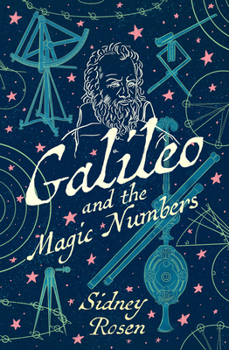Galileo and the Magic Numbers
Select Format
Select Condition 
Book Overview
Sixteenth century Italy produced a genius who marked the world with his studies and hypotheses about mathematical, physical and astronomical truths. His father, musician Vincenzio Galilei said, "Truth is not found behind a man's reputation. Truth appears only when the answers to questions are searched out by a free mind. This is not the easy path in life but it is the most rewarding." Galileo challenged divine law and the physics of Aristotle,...
Format:Paperback
Language:English
ISBN:1504068874
ISBN13:9781504068871
Release Date:October 2021
Publisher:Open Road Integrated Media LLC
Length:212 Pages
Weight:0.62 lbs.
Dimensions:0.5" x 5.3" x 8.0"
Age Range:13 to 17 years
Grade Range:Grades 8 to 12
Customer Reviews
2 ratings
Galileo's Story
Published by Thriftbooks.com User , 18 years ago
Galileo Galilei was fascinated with Pythagorean squares and triangles when he was a young child. Galileo was an avid musician learning the lute, organ, and viola in his childhood and his teens. He went to the University of Pisa for 2 years until his parents could no longer afford for him to go, so he achieved a free scholarship to go and finish his studies at the university, where he was nicknamed "Wrangler" for asking questions about if anyone had actually proved Aristotle's law of gravity. Galileo made his first invention at the University of Pisa, a thing that he called the Pulsiloga, which could be used to detect sickness. Galileo became a professor in Math at that university, only to get cast out by the Aristotle believers. Galileo moved to Venice, where he became professor of mathematics on a large salary. After he modernized the compass, Galileo became rich enough to own a fairly large house with a cook and servants who he overpaid out of generosity. Galileo became even more popular when he invented a stronger telescope and wrote three books on the sun and his discoveries about space. Later in life, Galileo was imprisoned for believing the sun was the center of the universe and teaching that it was and was accused by the Pope. He was found guilty of charge and was forced to spend the rest of his life at his friend's house, who offered for him to serve his punishment there. This book is denser reading in parts and can be read by older children and teens. The author included conversations between the Galilei family and their friends to make the book seem less like a timeline. The father and the mother of Galileo had arguments over Galileo's education, Galileo lectured about the position of the Earth going around the sun, and Michalangelo, Galileo's younger brother, promised to repay him multiple times. This book showed how smart Galileo was. His first invention he figured out when he was bored and swinging a pendulum back and forth and deciding to time it using his pulse as a timer. Gallileo's teachers even admittred that sometimes he would tell them that they were wrong or that they did thier math wrong. Galileo went to Venice and they gave him a salary of three times the amount that he recieved at the Univeresity of Pisa just to hear his opinions on certain things. This book shows the concerns and the little amount known about space around 1600. Galileo was the fist person to realize that the moon was not smooth like a marble, that Jupiter and Saturn had moons, and that the sun had spots that dissapeared after a while. This book is a great choice for older children and teens who want to learn more about a person who spoke his mind and became a famous scientist. C. Brady
Pythagorean Magic! Yea!
Published by Thriftbooks.com User , 21 years ago
I, for one, thought that this book was an awesome literary accomplishment, and for a historical biography, it was very interesting. What fascinated me the most about Galileo was his excitement for learning new things. As a boy his father, Vincezio Galilei, often told Galileo to think for himself. He told him that even if a person says something popular, it may not always be accurate. Even a person such as Aristotle could be corrected. Although this is true and is the basis of Galileo's life, the title of the book is referring to the Pythagorean Theorem. This was the very first thing taught to Galileo on his first day in a private noble school. What happens is the teacher calls Galileo to sit on the floor with him. He then takes out a multitude of pebbles from his pocket. He lays three pebbles on the floor in the shape of a triangle. He then points out that it is an isosceles triangle, because all of the sides are congruent. It fascinates young Galileo even more to learn that when more pebbles are placed at the base of the triangle, something happens. He sees a pattern happening with the sum of two sides. They seemed to be equal with the hypotenuse of the triangle. This, he learned, is what is known as the Pythagorean Theorem, or as his teacher called it, the Pythagorean Number Magic. It is most popular throughout the book, because it is the first thing that starts the most famous Philosopher in the world, Galileo Galilei, wanting to learn.






